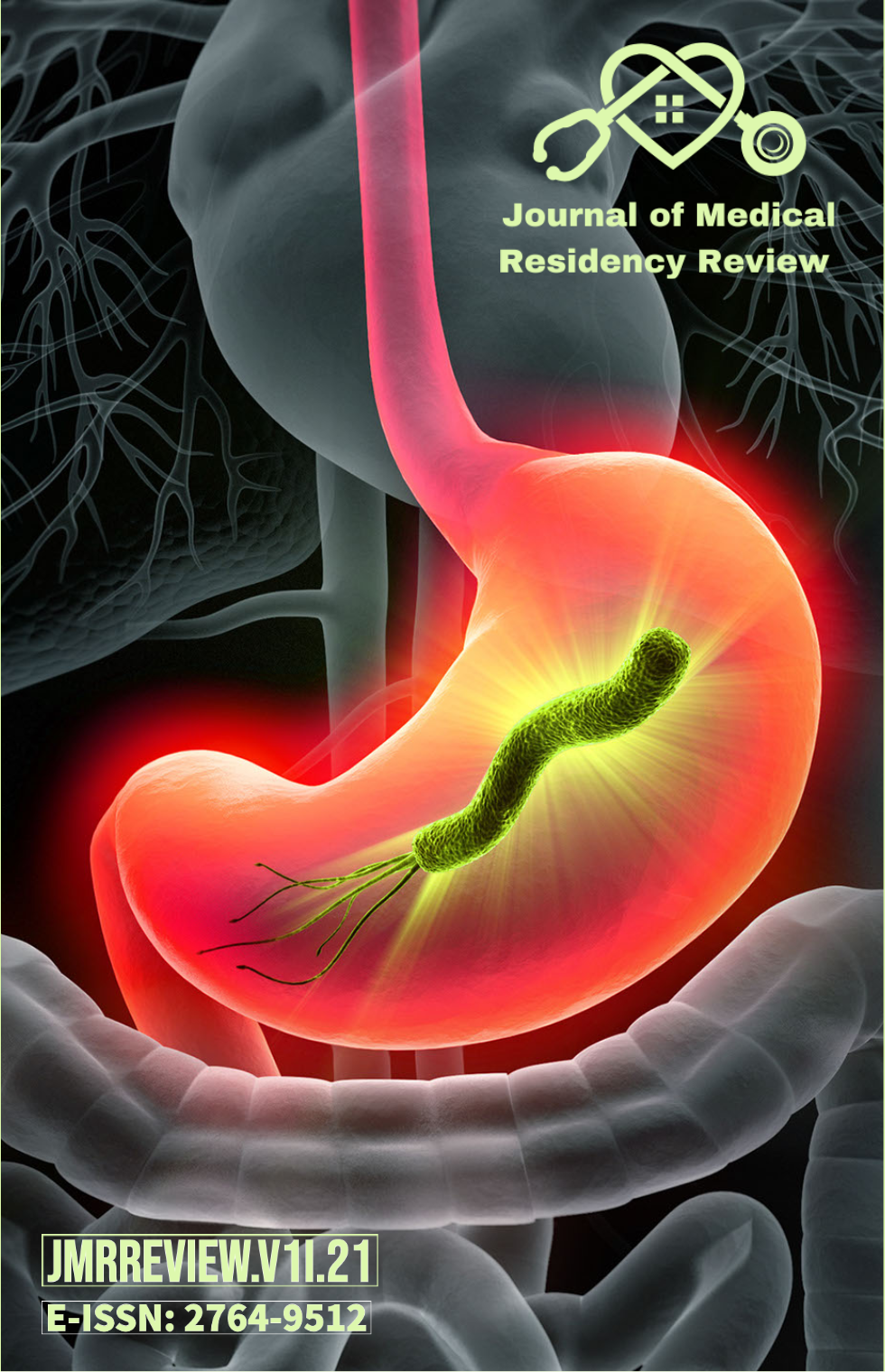Abstract
Background: Helicobacter pylori (H. pylori) is a gram-negative bacterium that inhabits the gastric environment of 60.3% of the world's population. It is well established that this microorganism is related to the development of gastroduodenal disorders, of which chronic gastritis, peptic ulcer, mucosa-associated lymphoma and gastric adenocarcinoma stand out. However, since the 1980s, increasing evidence has associated this infection with various extragastric manifestations.
Aim: Through a review of clinical trials, to synthesize the evidence on the treatment of H. pylori infections. Method: This is an exploratory study, based on the literature review method. The database chosen for the selection of papers was PUBMED, using the following search strategy: "helicobacter pylori"[title] AND treatment[title]. Studies published in the year 2022 were evaluated and any work that discussed the proposed theme and was a clinical trial was initially included in the sample.
Results: Initially, nine studies were identified that met the aforementioned search strategy. After reading the titles and abstracts, no text was excluded. Conclusion: In general, the effectiveness of high-dose dual regimens is comparable to triple and quadruple regimens, with the advantage of inducing fewer adverse effects in patients. Furthermore, the use of probiotics was effective in replacing bismuth in quadruple regimens, leading to greater eradication of H. pylori. However, its administration to prevent changes in the intestinal microbiota remains controversial. Finally, the administration of nitazoxanide replacing metronidazole in triple therapies proved to be more effective, mainly due to the resistance acquired by H. pylori to metronidazole.
References
AHMED, K. S. et al. Prevalence study to elucidate the transmission pathways of Helicobacter pylori at oral and gastroduodenal sites of a South Indian population. Singapore Medical Journal, v. 47, n. 4, p. 291–296, abr. 2006.
BI, H. et al. Efficacy and safety of high-dose esomeprazole-amoxicillin dual therapy for Helicobacter pylori rescue treatment: a multicenter, prospective, randomized, controlled trial. Chinese Medical Journal, v. 135, n. 14, p. 1707–1715, 20 jul. 2022.
CHOI, Y. J. et al. Triple Therapy-Based on Tegoprazan, a New Potassium-Competitive Acid Blocker, for First-Line Treatment of Helicobacter pylori Infection: A Randomized, Double-Blind, Phase III, Clinical Trial. Gut and Liver, v. 16, n. 4, p. 535–546, 15 jul. 2022.
COELHO, L. et al. IVTH BRAZILIAN CONSENSUS CONFERENCE ON HELICOBACTER PYLORI INFECTION. Arquivos de gastroenterologia, v. 55, n. 2, jun. 2018.
DORE, M. P. et al. Metagenomic Changes of Gut Microbiota following Treatment of Helicobacter pylori Infection with a Simplified Low-Dose Quadruple Therapy with Bismuth or Lactobacillus reuteri. Nutrients, v. 14, n. 14, p. 2789, 6 jul. 2022.
GODERSKA, K.; AGUDO PENA, S.; ALARCON, T. Helicobacter pylori treatment: antibiotics or probiotics. Applied Microbiology and Biotechnology, v. 102, n. 1, p. 1–7, 2018.
GRAHAM, D. Y.; LU, H.; YAMAOKA, Y. A report card to grade Helicobacter pylori therapy. Helicobacter, v. 12, n. 4, p. 275–278, ago. 2007.
GRAVINA, A. G. et al. Helicobacter pylori and extragastric diseases: A review. World Journal of Gastroenterology, v. 24, n. 29, p. 3204–3221, 7 ago. 2018.
GUAN, J.-L. et al. Comparison of high-dose dual therapy with bismuth-containing quadruple therapy in Helicobacter pylori-infected treatment-naive patients: An open-label, multicenter, randomized controlled trial. Pharmacotherapy, v. 42, n. 3, p. 224–232, mar. 2022.
HAN, B. et al. Sequential eradication of Helicobacter pylori as a treatment for immune thrombocytopenia in patients with moderate thrombocytopenia: a multicenter prospective randomized phase 3 study. Annals of Hematology, v. 101, n. 7, p. 1435–1445, jul. 2022a.
HAN, Y. Y. et al. Optimized dual therapy for treatment-naive patients of Helicobacter pylori infection: A large-scale prospective, multicenter, open-label, randomized controlled study. Helicobacter, v. 27, n. 5, p. e12922, out. 2022b.
LEJA, M. et al. Review: Epidemiology of Helicobacter pylori infection. Helicobacter, v. 24 Suppl 1, p. e12635, set. 2019.
LU, C. et al. Probiotic supplementation does not improve eradication rate of Helicobacter pylori infection compared to placebo based on standard therapy: a meta-analysis. Scientific Reports, v. 6, p. 23522, 21 mar. 2016.
MALFERTHEINER, P. et al. Current concepts in the management of Helicobacter pylori infection: the Maastricht III Consensus Report. Gut, v. 56, n. 6, p. 772–781, jun. 2007.
MLADENOVA, I.; DURAZZO, M. Transmission of Helicobacter pylori. Minerva Gastroenterologica E Dietologica, v. 64, n. 3, p. 251–254, set. 2018.
PAPASTERGIOU, V.; GEORGOPOULOS, S. D.; KARATAPANIS, S. Treatment of Helicobacter pylori infection: meeting the challenge of antimicrobial resistance. World Journal of Gastroenterology, v. 20, n. 29, p. 9898–9911, 7 ago. 2014.
RUGGIERO, P. Use of probiotics in the fight against Helicobacter pylori. World Journal of Gastrointestinal Pathophysiology, v. 5, n. 4, p. 384–391, 15 nov. 2014.
SANTOS, M. L. C. et al. Helicobacter pylori infection: Beyond gastric manifestations. World Journal of Gastroenterology, v. 26, n. 28, p. 4076–4093, 28 jul. 2020.
SEO, S. I. et al. Bismuth-Based Quadruple Therapy versus Metronidazole-Intensified Triple Therapy as a First-Line Treatment for Clarithromycin-Resistant Helicobacter pylori Infection: A Multicenter Randomized Controlled Trial. Gut and Liver, v. 16, n. 5, p. 697–705, 15 set. 2022.
SHAWKY, D. et al. Nitazoxanide-based therapeutic regimen as a novel treatment for Helicobacter pylori infection in children and adolescents: a randomized trial. European Review for Medical and Pharmacological Sciences, v. 26, n. 9, p. 3132–3137, maio 2022.
SJOMINA, O. et al. Epidemiology of Helicobacter pylori infection. Helicobacter, v. 23 Suppl 1, p. e12514, set. 2018.
STRACHAN, D. P. Hay fever, hygiene, and household size. BMJ (Clinical research ed.), v. 299, n. 6710, p. 1259–1260, 18 nov. 1989.
URITA, Y. et al. Role of infected grandmothers in transmission of Helicobacter pylori to children in a Japanese rural town. Journal of Paediatrics and Child Health, v. 49, n. 5, p. 394–398, maio 2013.
VIAZIS, N. et al. A Four-Probiotics Regimen Combined with A Standard Helicobacter pylori-Eradication Treatment Reduces Side Effects and Increases Eradication Rates. Nutrients, v. 14, n. 3, p. 632, 1 fev. 2022.

This work is licensed under a Creative Commons Attribution 4.0 International License.
